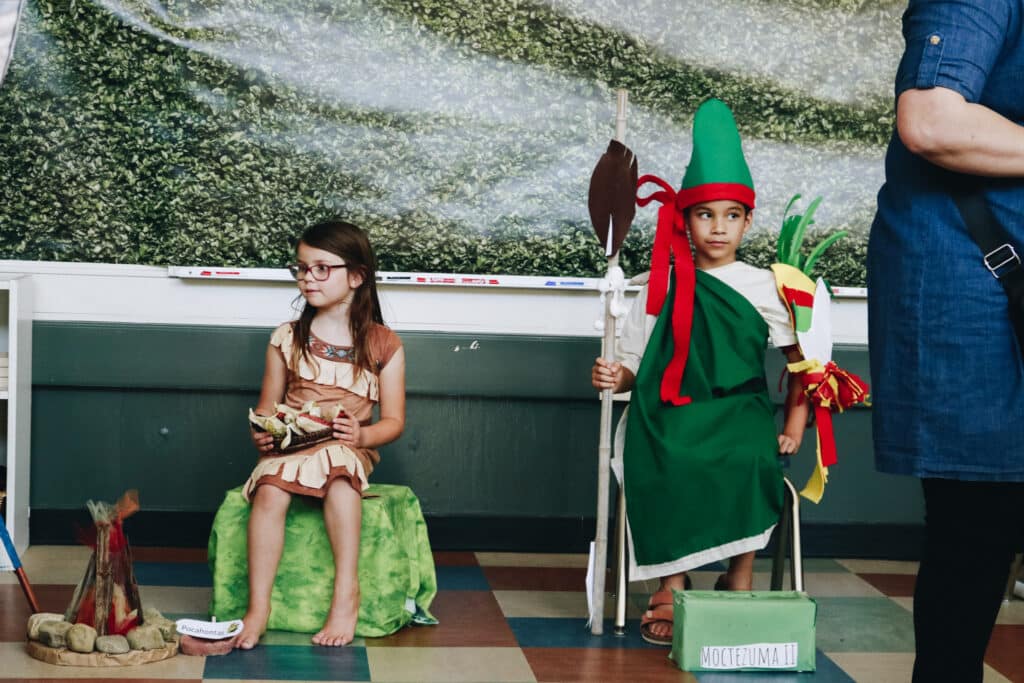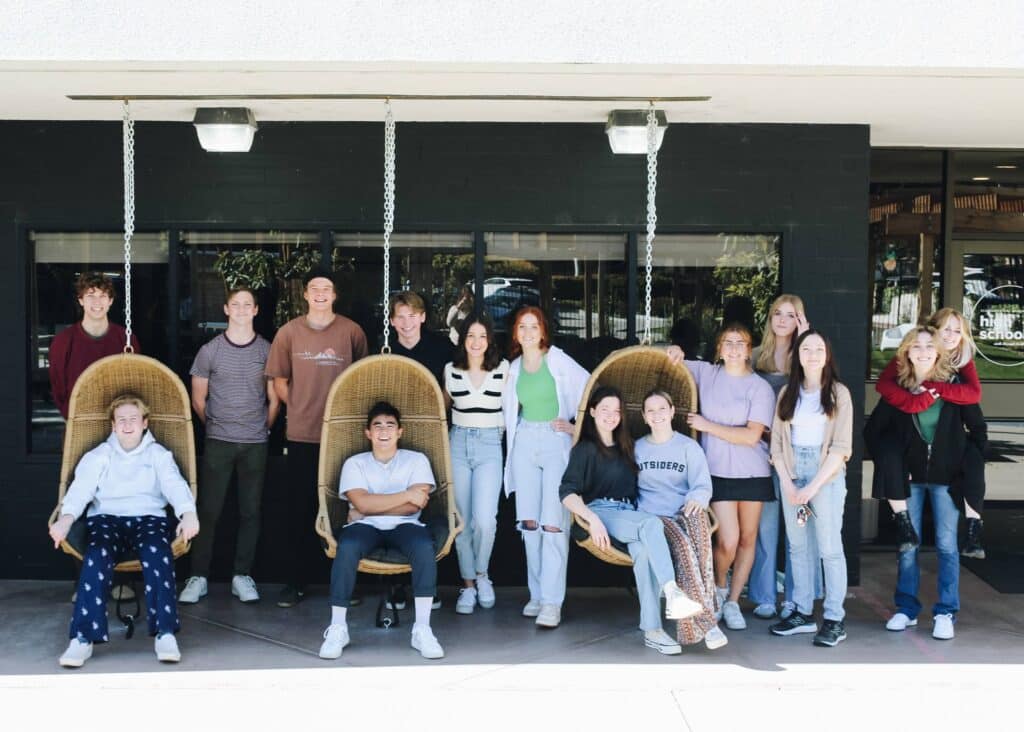
{source}
With a little time off approaching, we thought you might like to hear about another excellent book to add to your holiday reading list!
Pedagogic Ponderings
Mrs. Burns’ Book Review Blog
Pedagogic Ponderings is a blog review of pedagogic (educational) books by our own Jenna Burns. After teaching History and Language Arts at SLOCA UMS for five years, Jenna is taking this year off of teaching to care for her new daughter, Julianna. But she is not taking a break from learning! She is seeking out the best books on education, reading them, pondering them, and reviewing them for us. In her blog she gives us a snapshot of the books and how their educational philosophies connect to what we are doing at SLOCA. We hope her blog helps you better understand classical education and our school.

This month I’m reviewing The Core by Leigh A. Bortins. I chose this book to review because it is well respected in the home schooling community for its approach on how to do home-centered education. Read on to: see pictures of Mrs. Burns’ baby, hear about the way everyone learns, and understand what a car mechanic and the Trivium have in common.
I read The Core in the early weeks after the birth of my second daughter, Julianna; it was an emotional time. My first daughter, Aria, lived for eight days. Though her lifetime was heartbreakingly brief, it was enough time to fall in love with her eyes, to memorize her smell and to admire her spirit. It was enough time to learn profound lessons and to be forever changed.

(Pictured: Julianna and I are releasing a balloon at Aria’s memorial tree.)
When Julianna turned nine days old I was struck with a deep sense of gratitude for the gift of one more day with her. With so much lost in Aria I was determined not to lose out on a single, precious moment with Julianna.
Unfortunately, before long, my good intentions to make the most of each day created a crippling amount of pressure and anxiety. I’m learning now that all of life’s moments have value, even the less than perfect ones. This is why when my sister sent me this picture of her most recent DIY project the words resonated in me:

This quote from Steinbeck’s East of Eden reminds us we are better off when we give ourselves the space and grace to be human. Yet, it leaves me wondering: how can I do right by my child with the time I have been given? It is a question I wonder about home-centered education as well. There are so many valuable learning approaches and experiences that it is impossible to do them all. How can we pick and choose the most useful in order to provide the richest education for our children?
Leigh A. Bortins puts forth her answer to that question in The Core. In this easy to read book, Bortins systematically lays out what to teach (reading, writing, history, math, science, geography, fine arts) and how to teach it (the classical method). With each subject she outlines what a child should know and be able to do by the time he or she enters high school. She has her own website and blog that you can find here: http://leighbortins.com.
Though The Core is most useful to the full-time home schooler, the SLOCA parent would benefit in two ways from reading it. First, Bortins explains classical education very clearly and with helpful analogies. Second, she provides rigorous to-do lists for each subject. If you are wondering what your child should know regarding spelling, for example, the book will tell you. With each of these subjects she outlines, Bortins repeats the same three important educational beliefs. I think it only right to share these as my three take-aways!
Take away number one: Mastery of any subject starts with building a solid foundation of that subject’s grammar. Every subject and every career has its own grammar. Bortins uses the Oxford English Dictionary definition of grammar: “‘The fundamental principles or rules of an art or science,’” (48). To be a proficient writer, for example, a student must first understand the grammar of writing: proper sentence and paragraph structure, and the rules of punctuation and capitalization. In the same way, to be a good reader a student must first master phonics and spelling. That is why at SLOCA in the grammar grades (primary and intermediate) our studies focus on basic facts and foundational principles. In doing so we are helping our students build a, “Permanent, organized storage system in the brain with key ideas that they will continue to use lifelong,” (51). But how does the classical student master each subject’s grammar? The answer is my second take away.
Take away number two: Becoming fluent in any subject’s grammar requires over-practicing and memorization: “we know our students can provide a correct answer or reasonable solution (artifact) if they have over-practiced the tools of learning (process) [. . .] Classical educators know the artifact will only be as good as the art practiced, so over-practicing a core of learning skills is as important as finding the correct answer,” (43). Bortins makes the argument that everyone learns through repetitive practice. She suggests activities such as chanting the parts of speech, singing a song listing the presidents, and drilling math facts. At SLOCA we recite poetry, diagram sentences, memorize Latin vocabulary and much more. Repeatedly, Bortins warns against becoming bored with over-practicing and moving on too quickly to the logic stage of the Trivium. She offers reassurance that putting in the time to fully master the grammar stage will ensure the student’s success in the logic stage.
Take away number three: Home-centered education is most fully realized when the parent and child learn alongside one another. To educate according to Bortins’ plan this is absolutely necessary. Her program calls students to: draw a world map and label 200 places from memory; recall 160 – 200 historical dates; memorize the times tables to 15 X 15. I doubt I am alone when I say that I would have to learn alongside my child to achieve these accomplishments! Bortins encourages us, however, to consider the rich rewards this necessity offers. Not only do we get to grow our minds, we also have an opportunity to model for our children love of learning and perseverance. At SLOCA, reading the history and literature with your student is a great way to do this.
How The Core relates to SLOCA:
Now that we have looked at the main message of The Core, let’s explore how the book relates to what we are doing at SLOCA. At SLOCA, we are doing most, but not all, of the learning activities Bortins suggests. Nevertheless, as she says, “The goal is not to check off items on a list – one more assignment completed or one more answer given correctly,” (43). Though SLOCA may not always come at it in exactly the same way as The Core dictates, we are committed to the classical approach that will train our children’s brains first through grammar, then logic, and finally rhetoric.
Speaking of the Trivium, Bortins helped me understand the three stages in a new way with her analogy of a car mechanic. The mechanic must first begin with the grammar of cars,
learning the names for all the auto parts. He can then move on to the logic stage where he learns how the parts work together. He graduates to the rhetoric stage when he transfers his knowledge to the customer with his clear explanation of what repairs need to be made. It is easy to see in this example that each Trivium stage is necessary and builds off its predecessor. She provides a simple definition for each stage:
“You have the skill to learn anything if you know how to:
1. Memorize vocabulary and rules (also called grammar)
2. Process new concepts logically (also called dialectic), and
3. Clearly explain the grammar and dialectic to others (also called rhetoric),” (47).
It is tempting after reading The Core to allow the anxiety to kick in (Did I fail my middle school students by not requiring them to memorize hundreds of historical dates?) Instead, I remind myself that even if we haven’t arrived at perfection at SLOCA we have created something good, something worthwhile, something magical. After all, it is good to be a part of a school that does not claim it has it all figured out. Instead, we are always reflecting on where we have been as we carefully consider where we are going.
At the same time that we pursue perfecting the educational experience we offer our children, I hope we will avoid the anxiety of “Am I doing enough?” and instead trust in the time-tested classical method. May this confidence and big-picture perspective imbue us with grace for the hard moments and free our minds to simply enjoy this precious time we have with our children.

(Pictured: Julianna’s big smile!)
Bortins, Leigh A. The Core. New York: Palgrave Macmillan, 2010. Print.
Coming up next in January: How to Teach Your Children Shakespeare by Ken Ludwig

Thank you Mrs. Burns, for once more sharing a wonderful resource with us, while connecting with many of our common questions and concerns. We appreciate your words of reassurance and insight, and are delighted by your stories and your beautiful daughter Julianna!
We welcome comments about this topic and this book – have you read it? What do you think? Leave your thoughts in the comments section below.
Other reviews in this series:
The Read-Aloud Handbook by Jim Trelease
Ten Ways to Destroy the Imagination of your Child by Anthony Esolen
The Well-Trained Mind by Susan Wise Bauer and Jesse Wise
How to Teach Your Children Shakespeare by Ken Ludwig
Climbing Parnassus by Tracy Lee Simmons
Last Child in the Woods: Saving our Children from Nature-Deficit Disorder by Richard Louv
Play: How it Shapes the Brian, Opens the Imagination, and Invigorates the Soul by Dr. Stuart Brown
SLO Classical Academy is not affiliated with any of the above mentioned websites.











